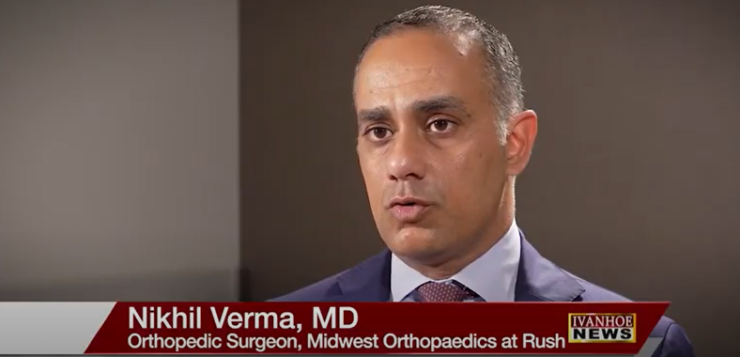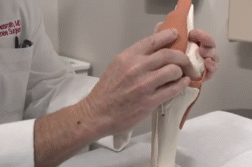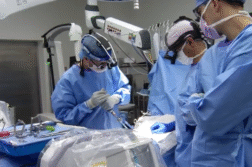Dr. Nikhil Verma, MD and Professor and director of Sports Medicine and shoulder, Rush University Medical Center and Midwest orthopedics at Rush, and head team physician for the Chicago White Sox talks about a new surgery for rotator cuff disease.
So, talk to me about this balloon spacer. What exactly is it?
VERMA: So, rotator cuff disease is the most common cause of shoulder pain that we see, particularly in our patients over the age of about 45 to 50. And for the vast majority of those patients, the gold standard has been to repair the tendon, which is to surgically fix the tendon back to the bone using a combination of sutures. But particularly in older patients what we find is as the tendon tears start to get larger and the tendon starts to retract, and the blood quality starts to deteriorate simply by the aging process, some of these tears cannot be repaired. That is, we try to stitch them, but they have a very high rate of failure or they’re so far retracted away from their normal insertion site that we just can’t mechanically repair them back into place. Traditionally, these have been very difficult patients to treat. We’ve tried to do things like partial repairs or using tissue grafts to try to bridge the defect between the rotator cuff and the bone and in some cases, we even have to replace the entirety of the shoulder. And so, the balloon device is really designed to fill this doughnut hole in patients that have good function in their shoulder, still have good cartilage so we don’t want to move to a replacement, are able to move their shoulder fairly well, but suffer from pain that doesn’t respond to conservative care. And in those patients, the balloon has been a very nice addition to give us a good reproducible option for patients that otherwise we didn’t really have a good solution for.
And this is mainly for the older patients.
VERMA: In general, this is patients in the 65 or older age group, that tends to be where we see larger tears or more chronic tears. It could be used in younger patients in specific situations, but currently the indications are for older patients.
Compared to the regular way of repairing the rotator cuff injury, what are the advantages and disadvantages of using this balloon?
VERMA: So, the regular way that we repair a tendon is by actually fixing it back down to the bone. We actually put some anchors in, anchors look like mini screws similar to what you may put into a drywall to hang a piece of art. And coming out of those anchors are sutures that allow us to stitch the tendon back into place. The downside of doing that is really two-fold. Number one is we have to go very slow with the recovery and the rehab in order to allow that tendon to heal to the bone. And number two is when we’re dealing with poor quality tissue or when the blood supply is poor or when the tendon is really retracted and so there’s a lot of tension on the repair when we repair it, there is unfortunately a high risk that that repair may fail within the first three to six months after surgery. For the balloon, rather than repairing the tendon what we actually do is put in a small spacer that sits between the top bone, our humerus, which is the top of our shoulder, and the top of our shoulder blade, which is called the acromion, and this provides a space in that interval. The reason the balloon works, we think, is because it allows patients to become pain free and then it allows them to rehab their shoulder so that even though after the balloon is gone their function remains and their pain relief remains. The biggest upside of the balloon is it’s a very fast, efficient procedure. It can generally be done in between 20 to 30 minutes. The data to date has been very positive in reducing pain and improving functions of daily living. The downside of the balloon is two-fold. Number one is we don’t really see as much strength recovery as we would with a repair because we’re not actually reattaching the tendon to bone, which is why it’s really designed for an older population who’s looking to get back to most of their daily activities, but not necessarily, for example, to become a laborer again or somebody who demands high level overhead work because of their recreation or their sport. Secondly, as the balloon goes away with time it’s designed to what we call resorb. And so, although we have data now that is 3, 4, 5 years out, we really don’t know how long this may last and is it really a forever-type procedure or is there something else down the road that we may need to do if these patients start to experience pain again?
After the balloon, I guess, absorbs or resorbs, they’re rotator cuff is still functional. So how long does the balloon tend to stay there before it disappears.
VERMA: This is the question that also shoulder surgeons asked themselves when we first heard about this device is how does a device that gets placed has an action that’s anywhere between 3 to 12 months, result in sustained benefit after the device is gone? It just doesn’t make intuitive sense for us. To understand that I think we need to take a step back, which is for people to recognize that there are many of us walking around today that have rotator cuff tears, have perfectly normal functioning shoulders and don’t even know that the tears exist. So, if we take all patients over the age of 70 and get an MRI scan or an ultrasound to look at their rotator cuff, probably about a 1/3 to 50% will have an actual tear in their shoulder, yet not even know it. And for the patients that we’re talking about here, these older patients with chronic tears, they’ve likely had these tears for 10, 15 years or longer. But something has happened that has caused them to decompensate, meaning they went from a very well-compensated state where the tear existed but didn’t cause them any functional disability, and then many times they have some type of a trivial injury that renders them symptomatic. Now, in some of those cases we’re able to do things like therapy or injections and make them asymptomatic again; that is, resolve their symptoms and take them back to that compensated world where they were before. So, I look at the balloon exactly like that. If we’re not successful with simple non-operative things, this is a way to normalize the position between the ball and the socket portion of our joint allow the body to then rehabilitate in a pain-free state, teach the muscles how to work again in the compensated fashion and they go back to that compensated world where they’ve existed for many years and hopefully will continue to exist even after the balloon is gone.
And you said the balloon typically goes away after 12 months?
VERMA: Yes the balloon is designed to be resorbable, which means it simply gets dissolved by the body. It’s typically completely gone, meaning no remnants of the balloon itself, by about 12 months. But the activity of the balloon due to deflation may actually cease after anywhere between three to six months.
And you said that the procedure to insert this is about 20, 30 minutes. How long is an average rotator cuff surgery?
VERMA: So, when we did a clinical trial, I was the principal investigator for a clinical trial here in the United States. We did this among 20 centers in U.S. and Canada and we tracked how long the procedures were. The average procedure for a reparative procedure was about 71 minutes. The average timeframe for the balloon procedure was approximate 40 minutes. So, it’s about a 30-minute difference. Now, that was delayed in the study because during the study you’re taking some notes, you’re recording data. So, both of the procedures are elevated, but we would estimate that a typical repair would be about 60 minutes and that the typical balloon procedure would be under 30 minutes.
So, talk to me about Cathy. What led her to come to you?
VERMA: So, Cathy had had some rotator cuff surgeries in the past. And like many people that we’ve just been discussing, those procedures worked for a short period of time, but ultimately her tendon failed again, and she was left with a retear of the rotator cuff that was causing her pain and functional disability. For many of these patients what really drives them crazy is they get a lot of night pain, so they have difficulty lying flat and their shoulder becomes painful at night, such that they can’t sleep. They’re constantly rolling over to try to find a comfortable position. So, when I saw Cathy, we looked at her images and her x-rays. She had a very well-maintained joint, so she wasn’t yet dealing with an arthritic situation. But she did have a large terrible rotator cuff and one that had already failed a repair in the past, which made me very nervous about repairing it again and expecting a different result. At that time, we were in the process of undertaking this clinical trial in the United States for this new device – balloon device that had been used in Europe at that point for about seven years. And so, I felt very comfortable that this was exactly the type of patient that may benefit from the balloon, both to provide her a more durable recovery, to not expose her to the risk of the rotator cuff failing, and it does accelerate the recovery for patients. They get much better and their rehabilitation goes much more quickly than a traditional repair.
Any restrictions after they get the balloon surgery?
VERMA: So, we do have a rehab requirement, but it’s much more accelerated compared to a typical repair. Patients are generally in a sling for somewhere between 10 to 14 days. We ask them to use their arm below shoulder level over the first four to six weeks. No real lifting heavy overhead objects for eight weeks. But I would say most patients are functional for their activities of daily living by two to three weeks and are kind of done with treatment, back to all of their normal activities by about 10 to 12 weeks.
And how does that compare to regular rotator cuff recovery?
VERMA: For rotator cuff surgery, many patients are in a sling for six weeks or more. They’re establishing activities of daily living somewhere around nine to 10 weeks. And they’re oftentimes in rehab for six to eight months before they finally reach their maximum outcome. So, we’re cutting that time in about half.
And for patients like Cathy, who have repeated tears in their rotator cuff, what do you think this can do for their quality of life?
VERMA: I think the problem for patients like Cathy is up until now we’ve had very little options available to manage these patients. We’ve tried to just treat them with injections being done every three to six months. Sometimes we actually go to the point of just replacing their shoulder because we don’t really have another procedure to offer them that’s going to provide durable benefits. And, of course, in many cases we just attempt to repair the rotator cuff again, we go much more slowly with the rehab, and we cross our fingers and hope for a better result. What I hope this does for patients like Cathy is they’re younger, they’re active, they want to maintain an active lifestyle. Their main complaint is pain. And I think if we can give them this option, even if it’s only a 10 or 12 or a 15-year option, during which we can give them extended pain relief and maintenance of function, I think that’s a real benefit for the patient. And importantly it has a very, very low risk profile, meaning we’re not really going to damage their shoulder or negate the ability to do anything more invasive in the future, like a replacement. I think it gives us a very nice option that hasn’t existed for this specific patient population in the past.
Anything I didn’t ask you that you feel is important for people to know?
VERMA: No. I think the highlight that we just got to make sure people understand is this is not substituting for all rotator cuffs. It’s very specific for a group of patients.
You said it’s only five years out from you guys, the research from the trial. So, would you know if this would prevent them from getting injured again?
VERMA: So, the long-term term data is unclear at this point, to be frank. The device has been approved for use and has been used in Europe for 10 years. The longest studies in Europe are about 5 to 7 years out now, in terms of reporting clinical data with a very substantial success rate. The trial now has patients that are going up on four years after implantation of the balloon, and they continue to do well. But in terms of how long the clinical benefit may actually be maintained, it’s very hard to estimate. Many of us feel comfortable that barring another injury many of these patients may continue to do well for long periods of time. But certainly, these are shoulders at risk. So, things like falls or traumas could result in further tearing of the remaining of the rotator cuff or fractures or damage to the joint surface. So, they’re not immune from future injury after this procedure.
When did it get FDA approved?
VERMA: About a month ago.
A month ago.
VERMA: Yeah.
Interview conducted by Ivanhoe Broadcast News.
END OF INTERVIEW
This information is intended for additional research purposes only. It is not to be used as a prescription or advice from Ivanhoe Broadcast News, Inc. or any medical professional interviewed. Ivanhoe Broadcast News, Inc. assumes no responsibility for the depth or accuracy of physician statements. Procedures or medicines apply to different people and medical factors; always consult your physician on medical matters.
If you would like more information, please contact:
ANN PITCHER
Sign up for a free weekly e-mail on Medical Breakthroughs called First to Know by clicking here




